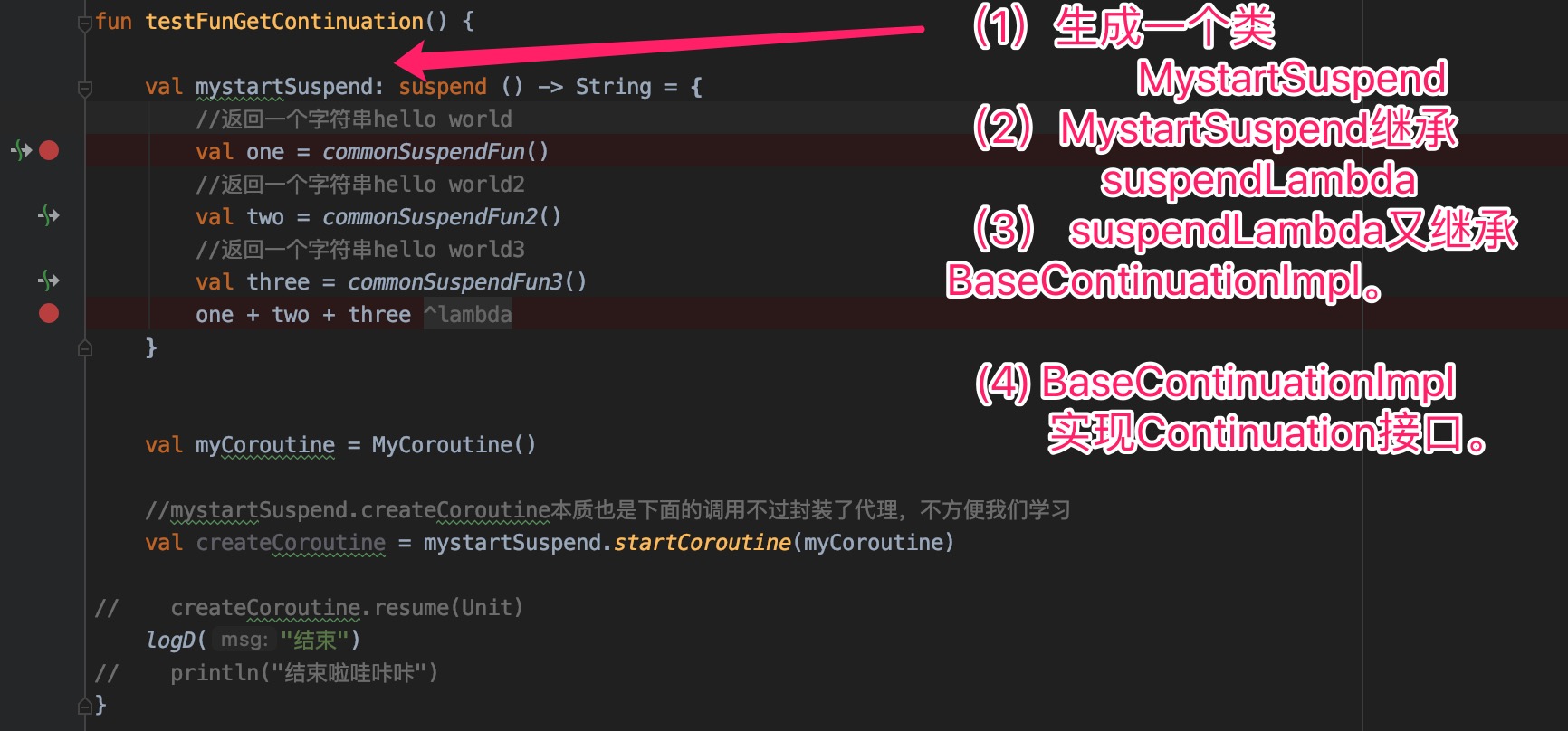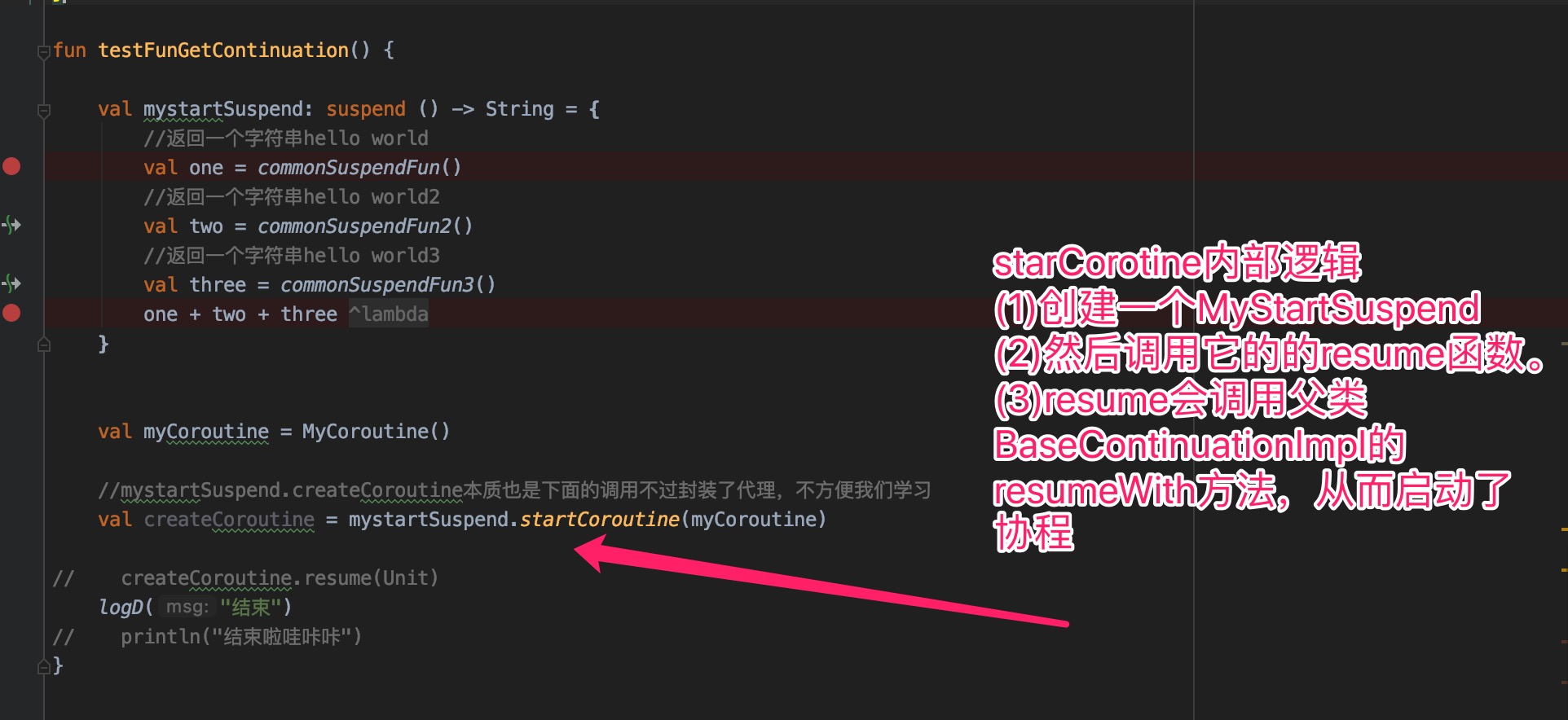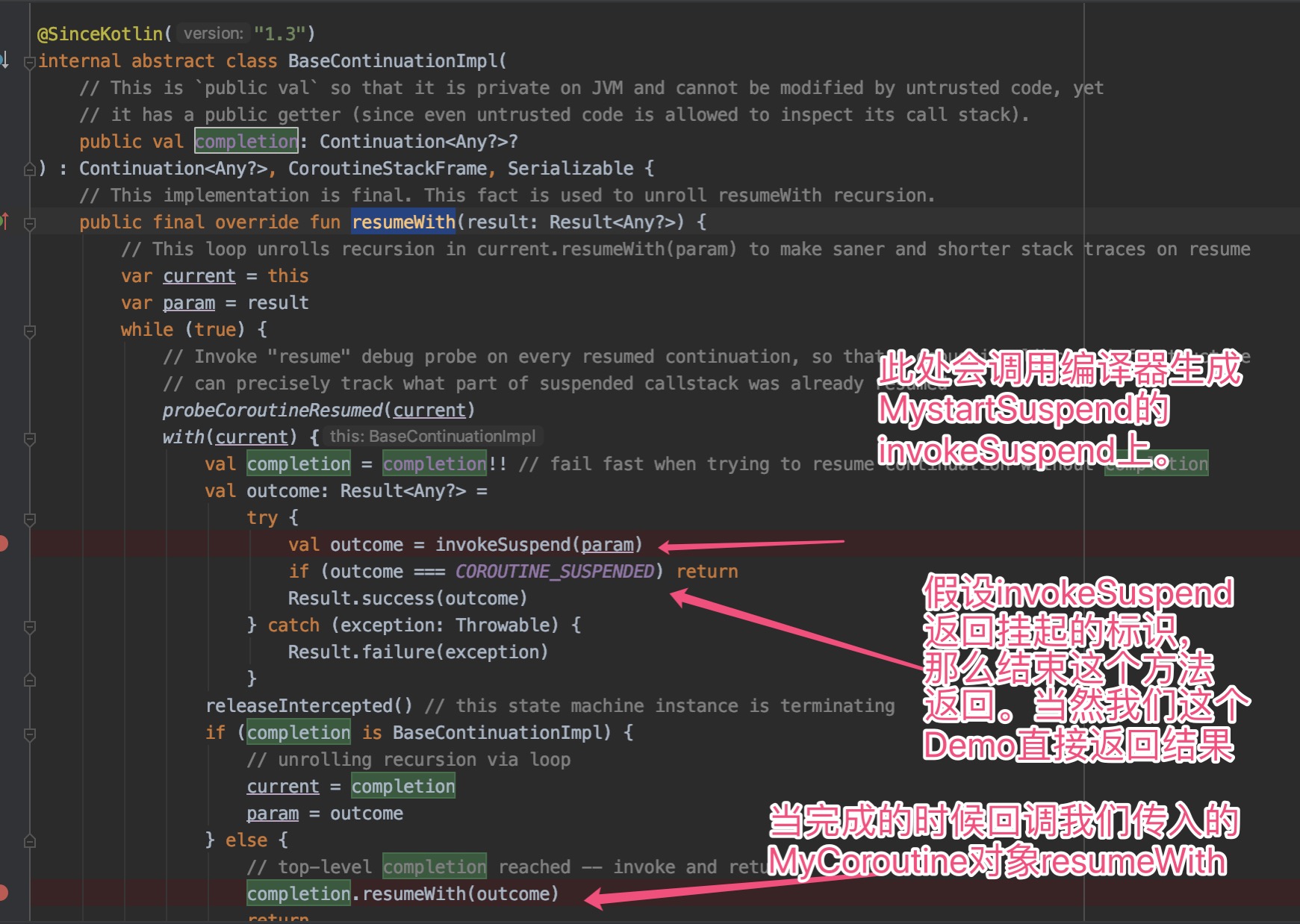Kotlin协程源码分析-4 状态机
今天就来分析所谓的协程的状态机
首先来看一个问题,我们知道suspend 函数会在编译后生成一个传入continuation的函数。
那么我们如何自己拿到这个传入的对象呢?这个对象又有什么作用?
请看如下代码即可
//com.example.studycoroutine.chapter.four.MyCoroutine.ktsuspend fun commonSuspendFun(): String {return "[hello world] "}suspend fun commonSuspendFun2(): String {return "[hello world 2] "}suspend fun commonSuspendFun3(): String {return "[hello world 3]"}fun testFunGetContinuation() {val mystartSuspend: suspend () -> String = {//返回一个字符串hello worldval one = commonSuspendFun()//返回一个字符串hello world2val two = commonSuspendFun2()//返回一个字符串hello world3val three = commonSuspendFun3()one+two+three}val myCoroutine = MyCoroutine()//mystartSuspend.createCoroutine本质也是下面的调用不过封装了代理,不方便我们学习val createCoroutine = mystartSuspend.createCoroutineUnintercepted(myCoroutine)createCoroutine.resume(Unit)}//com.example.studycoroutine.chapter.two.MyCoroutine.ktclass MyCoroutine() : Continuation<String> {override fun resumeWith(result: Result<String>) {logD("MyCoroutine 回调resumeWith 返回的结果 " + result.getOrNull())}override val context: CoroutineContextget() = kotlin.coroutines.EmptyCoroutineContext}
输出结果:
[main] MyCoroutine 回调resumeWith 返回的结果 [hello world] [hello world 2] [hello world 3]
想要弄懂就必须从编译后的字节码入手.
反编译结果结构图:
MyCoroutineKt.testFunGetContinuation.mystartSuspend.1对应我们的suspend lambda对象mystartSuspend。而这个对象主要作用就是用来维护 状态机,这个也懂kotlin 协程的关键。
MyCoroutineKt.testFunGetContinuation.mystartSuspend.1被我改名为MystartSuspend,方便查看编译后的源码,下面的反编译字节码翻译成java语法,部分被我修饰了。
class MystartSuspend extends SuspendLambda implements Function1 {Object saveResultOne;Object saveResultTwo;int label;MystartSuspend(Continuation continuation) {super(1, continuation);}public final Continuation create(Continuation continuation) {return new MystartSuspend(continuation);}public final Object invoke(Object continuation) {return ((MystartSuspend) this.create(((Continuation) continuation))).invokeSuspend(Unit.INSTANCE);}public final Object invokeSuspend(Object $result) {Object invokeResult;Object v3;String v1_2;Object resultThree;String resultOne;String resultTwo;Object SUSPEND_FLAG = IntrinsicsKt.getCOROUTINE_SUSPENDED();int v1 = this.label;if (v1 == 0) {ResultKt.throwOnFailure($result);this.label = 1;invokeResult = MyCoroutineKt.coMystartSuspendonSuspendFun(((Continuation) this));if (invokeResult == SUSPEND_FLAG) {return SUSPEND_FLAG;}label_40:v1_2 = (String) invokeResult;this.saveResultOne = v1_2;this.label = 2;v3 = MyCoroutineKt.coMystartSuspendonSuspendFun2(((Continuation) this));if (v3 == SUSPEND_FLAG) {return SUSPEND_FLAG;}label_46:String two = (String) v3;this.saveResultOne = v1_2;this.saveResultTwo = two;this.label = 3;resultThree = MyCoroutineKt.coMystartSuspendonSuspendFun3(((Continuation) this));if (resultThree == SUSPEND_FLAG) {return SUSPEND_FLAG;}resultOne = v1_2;resultTwo = two;} else {if (v1 != 1) {if (v1 != 2) {if (v1 == 3) {resultTwo = (String) this.saveResultTwo;resultOne = (String) this.saveResultOne;ResultKt.throwOnFailure($result);resultThree = $result;return resultOne + resultTwo + (((String) resultThree));}throw new IllegalStateException("call to \'resume\' before \'invoke\' with coroutine");}v1_2 = (String) this.saveResultOne;ResultKt.throwOnFailure($result);v3 = $result;goto label_46;}ResultKt.throwOnFailure($result);invokeResult = $result;goto label_40;}return resultOne + resultTwo + (((String) resultThree));}}
调用类反编译
public final class MyCoroutineKt {public static final Object commonSuspendFun(Continuation $completion) {return "[hello world] ";}public static final Object commonSuspendFun2(Continuation $completion) {return "[hello world 2] ";}public static final Object commonSuspendFun3(Continuation $completion) {return "[hello world 3]";}public static final void testFunGetContinuation() {ContinuationKt.createCoroutine(((Function1)new MystartSuspend(null)), ((Continuation)new MyCoroutine())).resumeWith(Result.constructor-impl(Unit.INSTANCE));}}
首先我们要知道创建我们的代码调用createCoroutineUnintercepted调用返回的对象是什么。
//kotlin.coroutines.intrinsics.IntrinsicsJvm.ktpublic actual fun <T> (suspend () -> T).createCoroutineUnintercepted(completion: Continuation<T>): Continuation<Unit> {//返回myCoroutine对象val probeCompletion = probeCoroutineCreated(completion)//if会返回true 上一篇文章有讲过lambda会编译成BaseContinuationImpl类//this 就是我们的mystartSuspend对象,也就是MystartSuspend类return if (this is BaseContinuationImpl)//调用MystartSuspend的create方法,最终返回MystartSuspend实例create(probeCompletion)elsecreateCoroutineFromSuspendFunction(probeCompletion) {(this as Function1<Continuation<T>, Any?>).invoke(it)}}
综上所述createCoroutineUnintercepted返回MystartSuspend对象实例。
在返回MystartSuspend后我们调用resume启动协程。MystartSuspend是一个Continuation,调用resume的函数声明,发现是一个扩展函数。
public inline fun <T> Continuation<T>.resume(value: T): Unit =resumeWith(Result.success(value))
经过继承链会调用到BaseContinuationImpl对象上的resumeWith方法
//kotlin.coroutines.jvm.internal.BaseContinuationImpl.ktinternal abstract class BaseContinuationImpl(public val completion: Continuation<Any?>?//我们传入myCoroutine对象) : Continuation<Any?>, CoroutineStackFrame, Serializable {public final override fun resumeWith(result: Result<Any?>) {var current = thisvar param = resultwhile (true) {//先无视探针相关内容probeCoroutineResumed(current)with(current) {//用于快速错误监测有没有传入completion对象val completion = completion!!val outcome: Result<Any?> =try {//调用子类的状态机函数,这部分往往有编译器实现//当然你也可以自己实现。在我们的MystartSuspend类中//invokeSuspend函数你就看到了val outcome = invokeSuspend(param)//如果状态机返回的挂起标识那么退出循环//等候下一次调用Continuation的resumeWith函数调用在进入if (outcome === COROUTINE_SUSPENDED) returnResult.success(outcome)} catch (exception: Throwable) {Result.failure(exception)}releaseIntercepted()if (completion is BaseContinuationImpl) {current = completionparam = outcome} else {//如果状态返回了结果二部是挂起标识那么结束全部流程,//并且回调我么demo中MyCoroutine对象completion.resumeWith(outcome)return}}}}}
综上所述我么总结一下流程:
- 步骤一:我们创建一个
Continuation对象用户接受挂起函数完成的通知。本案例为MyCoroutine - 步骤二:创建一个
suspend lambda。本案例为mystartSuspend - 步骤三:
mystartSuspend内部调用其他挂起函数 - 步骤四:
createCoroutineUnintercepted创建一个新的Continuation这个Continuation对象是步骤二的suspend lambda所生成的(编译器会生成一个SuspendLambda对象) - 步骤五:调用
suspend lambda的continuation的onresume. - 步骤六:
suspend lambda的continuation的父类BaseContinuationImpl内部resumeWith被回调 - 步骤七:父类
BaseContinuationImpl内部resumeWith内部调用子类invokeSuspend并获取结果 - 步骤八:子类
invokeSuspend调用内部的挂起函数,并把自己作为continuation传入 - 步骤九:获取
invokeSuspend返回结果。如果返回不是COROUTINE_SUSPENDED,协程结束回调监听完成的continuation类(本案例中MyCoroutine被回调)。如果返回COROUTINE_SUSPENDED那么结束父类BaseContinuationImpl内部resumeWith的死循环,并下一次等候回调resumeWith(因为子类的invokeSuspend中调用挂起函数传入的自己(continuation)给挂起函数,挂起函数完成时回调他的resumeWith方法) - 步骤十:重复步骤八和九。直到返回结果
我们这里回过头来看看编译器帮我生成类(请看注释)
class MystartSuspend extends SuspendLambda implements Function1 {Object saveResultOne;Object saveResultTwo;int label;public final Object invokeSuspend(Object $result) {Object invokeResult;Object v3;String v1_2;Object resultThree;String resultOne;String resultTwo;Object SUSPEND_FLAG = IntrinsicsKt.getCOROUTINE_SUSPENDED();// (一)状态lable为0int v1 = this.label;if (v1 == 0) {ResultKt.throwOnFailure($result);// (二)状态lable为1this.label = 1;// (三) 调用第一个挂起函数,传入自己做为参数,并检查返回值//如果返回SUSPEND_FLAG就返回函数。当挂起函数用传入的Continuation//调用resume时候又重新回到这个invokeSuspend方法//当然我们这里由于不会返回SUSPEND_FLAG 所以继续向下运行invokeResult = MyCoroutineKt.coMystartSuspendonSuspendFun(((Continuation) this));if (invokeResult == SUSPEND_FLAG) {return SUSPEND_FLAG;}label_40:v1_2 = (String) invokeResult;this.saveResultOne = v1_2;//(四) 更新label状态为2this.label = 2;//(五) 调用挂起函数 与(三)相同v3 = MyCoroutineKt.coMystartSuspendonSuspendFun2(((Continuation) this));if (v3 == SUSPEND_FLAG) {return SUSPEND_FLAG;}label_46:String two = (String) v3;this.saveResultOne = v1_2;this.saveResultTwo = two;//(六) 更新lable为3this.label = 3;// (七) 调用最后一个挂起函数 同样与(三)一样检查结果resultThree = MyCoroutineKt.coMystartSuspendonSuspendFun3(((Continuation) this));if (resultThree == SUSPEND_FLAG) {return SUSPEND_FLAG;}resultOne = v1_2;resultTwo = two;} else {if (v1 != 1) {if (v1 != 2) {if (v1 == 3) {resultTwo = (String) this.saveResultTwo;resultOne = (String) this.saveResultOne;ResultKt.throwOnFailure($result);resultThree = $result;return resultOne + resultTwo + (((String) resultThree));}throw new IllegalStateException("call to \'resume\' before \'invoke\' with coroutine");}v1_2 = (String) this.saveResultOne;ResultKt.throwOnFailure($result);v3 = $result;goto label_46;}ResultKt.throwOnFailure($result);invokeResult = $result;goto label_40;}//(八)返回结果return resultOne + resultTwo + (((String) resultThree));}}
如果你逻辑还是很乱证明我没讲好。看一下图吧



华丽的分割线
上面的例子总是在说什么返回挂起标识COROUTINE_SUSPENDED,但是我们怎么返回这个变量?并且状态机传入Continuation对象我们怎么在挂起函数拿到?
挂起函数如何拿到Continuation?





























还没有评论,来说两句吧...